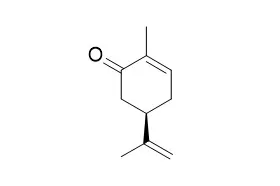| In vitro: |
| Plant Disease, 2007, 91(1):30-35. | | Fungicidal Activity of Plant Volatile Compounds for Controlling Monilinia laxa in Stone Fruit .[Reference: WebLink] | Nine plant-volatile compounds were tested for their activity against Monilinia laxa, the cause of brown rot in stone fruit.
METHODS AND RESULTS:
In vitro trials on conidial germination and mycelial growth showed a consistent fungicidal activity of trans-2-hexenal, carvacrol, and citral, whereas trans-cinnamaldehyde, hexanal, (-)-Carvone, eugenol, 2-nonanone, and p-anisaldehyde exhibited a progressively lower inhibition. The best inhibitor of conidial germination was trans-2-hexenal (effective dose for 50 and 90% inhibition [ED50 and ED95] = 7.53 and 9.4 μl/liter, respectively; minimal inhibitory concentration [MIC] = 12.3 μl/liter], whereas carvacrol was the best inhibitor of mycelial growth (ED50 and ED95 = 2 and 3.4 μl/liter, respectively; MIC = 6.1 μl/liter). The three most active compounds in in vitro studies also were tested in vivo as postharvest biofumigants.
CONCLUSIONS:
The best control of brown rot was with trans-2-hexenal (efficacy ranging from 46.2 to 80.3%, depending on cultivar), whereas citral and carvacrol resulted in a lower efficacy of 40 and 32.9%, respectively. Fumigation with trans-2-hexenal at concentrations that stopped decay did not cause any visible disorders to plum, whereas it was phytotoxic to apricot, peach, and nectarine and produced off-odors or off-flavors in all species of stone fruit tested. | | Journal of Chemical Ecology, 2009, 35(5):518-525. | | Fumigant and Contact Toxicities of Monoterpenes to Sitophilus oryzae (L.) and Tribolium castaneum (Herbst) and their Inhibitory Effects on Acetylcholinesterase Activity.[Reference: WebLink] |
METHODS AND RESULTS:
A comparative study was conducted to assess the contact and fumigant toxicities of eleven monoterpenes on two important stored products insects--, Sitophilus oryzae, the rice weevil, and Tribolium castaneum, the rust red flour beetle. The monoterpenes included: camphene, (+)-camphor, (-)-Carvone, 1-8-cineole, cuminaldehyde, (L: )-fenchone, geraniol, (-)-limonene, (-)-linalool, (-)-menthol, and myrcene. The inhibitory effect of these compounds on acetylcholinesterase (AChE) activity also was examined to explore their possible mode(s) of toxic action. Although most of the compounds were toxic to S. oryzae and T. castaneum, their toxicity varied with insect species and with the bioassay test. In contact toxicity assays, (-)-Carvone, geraniol, and cuminaldehyde showed the highest toxicity against S. oryzae with LC(50) values of 28.17, 28.76, and 42.08 microg/cm(2), respectively. (-)-Carvone (LC(50) = 19.80 microg/cm(2)) was the most effective compound against T. castaneum, followed by cuminaldehyde (LC(50) = 32.59 microg/cm(2)). In contrast, camphene, (+)-camphor, 1-8-cineole, and myrcene had weak activity against both insects (i.e., LC(50) values above 500 microg/cm(2)). In fumigant toxicity assays, 1-8-cineole was the most effective against S. oryzae and T. castaneum (LC(50) = 14.19 and 17.16 mg/l, respectively).
Structure-toxicity investigations revealed that (-)-Carvone--, a ketone--, had the highest contact toxicity against the both insects. 1-8-Cineole--, an ether--, was the most potent fumigant against both insects. In vitro inhibition studies of AChE from adults of S. oryzae showed that cuminaldehyde most effectively inhibited enzyme activity at the two tested concentrations (0.01 and 0.05 M) followed by 1-8-cineole, (-)-limonene, and (L)-fenchone. 1-8-Cineole was the most potent inhibitor of AChE activity from T. castaneum larvae followed by (-)-Carvone and (-)-limonene.
CONCLUSIONS:
The results of the present study indicate that (-)-Carvone, 1,8-cineole, cuminaldehyde, (L)-fenchone, and (-)-limonene could be effective biocontrol agents against S. oryzae and T. castaneum. |
|






 Cell. 2018 Jan 11;172(1-2):249-261.e12. doi: 10.1016/j.cell.2017.12.019.IF=36.216(2019)
Cell. 2018 Jan 11;172(1-2):249-261.e12. doi: 10.1016/j.cell.2017.12.019.IF=36.216(2019) Cell Metab. 2020 Mar 3;31(3):534-548.e5. doi: 10.1016/j.cmet.2020.01.002.IF=22.415(2019)
Cell Metab. 2020 Mar 3;31(3):534-548.e5. doi: 10.1016/j.cmet.2020.01.002.IF=22.415(2019) Mol Cell. 2017 Nov 16;68(4):673-685.e6. doi: 10.1016/j.molcel.2017.10.022.IF=14.548(2019)
Mol Cell. 2017 Nov 16;68(4):673-685.e6. doi: 10.1016/j.molcel.2017.10.022.IF=14.548(2019)